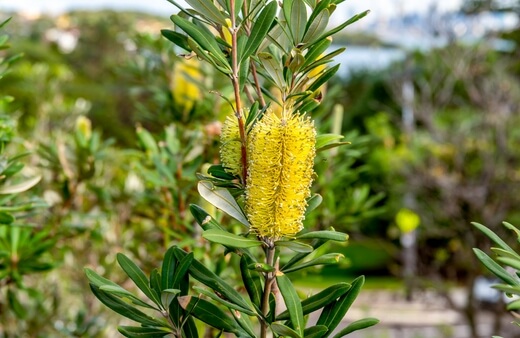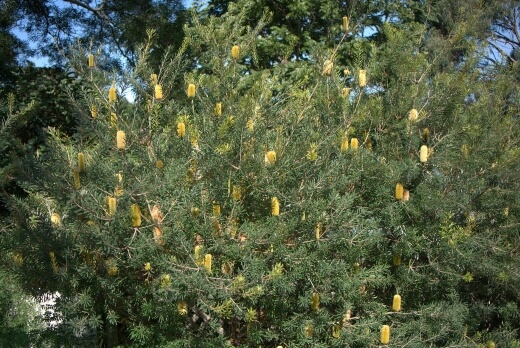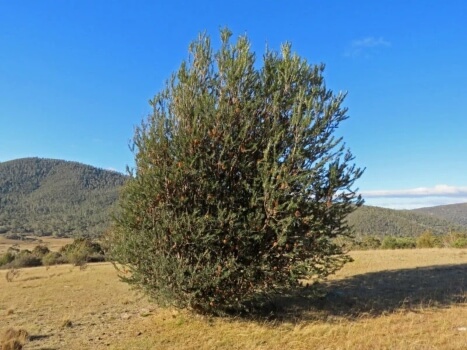Growing native plants is a great way to bring wildlife into the garden, as well as taking pride in the natural wonders this country has to offer. There are few garden plants more ironically Australian than Banksia, so we thought we’d run through some of the key factors in growing our favourite; Banksia marginata, the silver banksia.
I’ve always adored Banksia, for its statement flowers and their all-encompassing, honey-like fragrance, but Banksia marginata offers something else, with its eye-catching silvery foliage that grabs the sun, and shines it back around the garden late into the evening.
Follow our guide to growing Banksia marginata to grow your own at home, from seed, cuttings, or young plants, into mature shrubs with boldly flavoured edible flowers.
More...

Family: | Proteaceae |
|---|---|
Genus: | Banksia |
Species: | marginata |
Common Name: | Silver banksia |
Location: | Outdoor |
Type: | Tree/Woody shrub |
Growth: | 1-12m tall |
Sun requirements: | Full sun, dappled sun |
Foliage Colour: | Silver-green |
Flower Colour: | Creamy green to yellow |
Flowering: | Winter to Spring |
Fruit: | None |
Maintenance level: | Low |
Poisonous for pets: | Toxic to dogs and cats – causing irritation and vomiting |
What is Banksia marginata?
Banksia marginata is a native shrub, or small tree, found throughout southwestern Australia. Its pale grey bark is instantly recognisable at any time of year, and when its new foliage pushes through in spring, the silvery-green needles dance in the light.
As the evergreen foliage matures through summer, the old leaves are replaced, and photosynthesis begins to feed the plant with sugars. Those sugars come out in the glorious flower aroma, packed with notes of honey, pine and citrus.

Silver Banksia’s Natural Habitat
Banksia marginata is native to southwestern Australia and mostly found between Armidale and the Eyre Peninsula. However, it manages to thrive in Tasmania and can be found growing happily across the warmer east coast.
Like most banksias, the silver banksia tree grows naturally in forest and scrubland but has naturalised well in moorland, heaths, and even coastal zones giving it a reputation as a fairly bulletproof hedge.
Discover the world of banksias and its different varieties here.
How to Grow Banksia marginata
Banksia marginata is one of the easiest species of banksia to grow at home. All you need is 6 hours of sunlight and well-drained soil. If you can provide that, there’s very little that will affect your plants. Follow our step-by-step guide to planting below for more tips.
Best Conditions When Planting Banksia marginata
Banksia roots are tough, but perhaps less willing to work through harsh or damp soil than you might expect, so digging a reasonably large planting hole is a must.
I always start by digging out a hole at least twice the size and depth of any banksia, to make sure any drainage problems can be adapted by adding sand, or compost to achieve a reasonably fertile but draining consistency.
For hedging, dig a wide channel, at least twice as deep as the root ball, then backfill by half. This just gives an easy root run to establish hedging plants a little faster.

Source: Mallee Design
Soil for Silver Banksia
Sandy soils are best for banksia. They don’t need much in the way of fertilisers, but if your soil is really, really, poor, add some good organic compost to the planting site so they’re not struggling for nutrients.
Refer to our guide on how to choose the best composters to help you make your own organic compost.
Watering Needs
Like any tree or shrub, Banksia marginata should be watered in extremely well when it’s first planted. This helps the soil to settle around the roots, and remove any air pockets where fungal problems can duplicate.
After watering in, the only time you need to water banksia is during extreme summer droughts. Natural rainfall is easy enough for these native plants to cope.
Light & Temperature Preference
Silver leaf banksia should be planted in full sun where possible but will cope in dappled light provided they get at least 6 hours of direct light per day as a minimum. Keep in mind that Banksia marginata is native to the cooler south, so in northern and eastern Australia, dappled light, and a touch more water can be beneficial.
How to Propagate Banksia marginata
Most Banksias are best propagated from cuttings as their seeds are easy to germinate, and fast-growing, but because of the slightly softer stems of Banksia marginata, it’s much easier to take cuttings from new shoots, provided they haven’t begun to flower.
I’ve thrown together a really simple guide to propagating silver leaf banksia with both methods below.

Propagating Banksia marginata from Seeds
Like all Banksias, collecting ripe seeds from pollinated flowers is the best way to get reliable germination, but with a little bit of preparation, dried seeds will work just as well.
Start by exposing banksia seeds to heat. This can be hot smoke, hung over the BBQ, or in an oven at 120-140°C for 45-60 minutes. This opens the seed pods, and splits the hard shells, allowing you to carefully remove each seed.
Then, sow them on any well-drained seed compost, or sandy compost mix, and water them gently whenever the soil starts to dry. When the first true leaves appear (a pair of elongated silvery leaves, as opposed to the initial germination leaves), carefully transplant them into their own pots to develop.
Propagating Silver Banksia Tree from Cuttings
While heat treating seeds might seem complicated, it’s more reliable than soaking, or sanding seed casings, and recreates nature. Banksias produce fewer potential rooting cells than most plants though, so cuttings are far from a natural way to propagate them, which means you’ll need a few extra tools.
- Start by getting your hands on a decent rooting hormone, and completely sterilise all your tools.
- Fill tall pots with loose sandy compost, mixed with perlite, then place them in a heated propagator at a temperature of 25°C.
- Cut 10-15 cm lengths of non-flowering shoots, and strip the lower leaves.
- Dip the base of the cutting into rooting hormone, and add it into individual pots.
- Water lightly, and occasionally as over-watering will cause them to rot.
- After 3 months, you should notice germination.
- Leave them in their containers until the growth is slightly more vigorous, and roots have developed, then pot them into larger containers.
Caring for Banksia marginata

Source: Great Ocean Road Nursery
Once a silver banksia tree has developed and matured, there is very little ongoing care required. Just water them through harsh summers, and prune them once or twice a year in spring and autumn to keep them to the shape and size you like.
Banksia will never be a completely formal hedge and is always fluffy around the edges, which is part of its charm, but you can still achieve some surprisingly neat hedges with two prunes per year.
You’ll lose flowers when you prune, but they’ll come back within a week or two, so don’t be overly careful.
Banksia marginata Bush Tucker Guide
Banksia marginata flowers produce an extremely sweet nectar, similar to honeysuckle, which can be eaten directly from the flower, or steeped in water to produce a sweet tea.
The rest of the plant isn’t poisonous, but it would definitely give you a funny tummy, so steer clear of the seeds, leaves, and stems and stick to the stuff that tastes good – the flowers.
The most common way to eat banksia flowers is to simply suck the sap from them, in its pure form, but personally, I prefer extracting it in water, then leaving a jig in the fridge for cool sweet tea.
Silver Banksia Pests and Diseases to Look Out For
Like most hardy native shrubs, Banksia suffers from very few diseases and even fewer pests. They have developed to thrive in their native conditions, and, as luck would have it, that’s right here in Australia.
You might spot aphids on spring growth, or in early winter, but they will almost never cause problems significant enough to need treatment. The only two diseases to be particularly concerned about are root rot and over fertilisation.
Overwatering any Banksia, but particularly B. marginata, will cause the plant to look dry, with yellowing leaves, dropping flowers, and eventually crisp, dead centres caused by fungal root problems.
The biggest mistake you can make is to keep watering when a banksia looks dry. Make sure to check the soil. If it’s at all moist, the most likely cause is root rot, and the safest option is to take the plant out and wash the root ball off, before cutting out any damaged roots.
This will prevent spread. Before you replant your banksia, keep it in a container for a few weeks. If it’s growing fine, with no new signs of damage, it’s safe to plant back out without infecting the rest of your hedge.
Banksia marginata Frequently Asked Questions

Does Banksia marginata have invasive roots?
Banksia marginata roots can be pretty thuggish, so don’t plant within 5m of the house, or foundations. The chances of damage are minimal, but it’s worth noting that their roots can often spread up to twice the height of the tree.
How do you train Banksia marginata as a tree?
If you want to try something different, or just don’t fancy restricting your silver banksia to a shrub or hedge form, it’s really easy to encourage it to develop into a tall, happy and healthy tree. Simply prune out any lower branches, and encourage a leading stem.
How long does Banksia marginata live?
Banksia marginata can live for over 100 years, making them a brilliant investment for any home. If you want a reliable, bomb-proof hedge, then Banksia is the way to go.
For me, Banksia marginata, with its long life span, and muted flowers, is a great choice, as it sits unassumingly around the boundary of any home, and allows you to plant and change up your garden colour scheme without dominating it.
Is Banksia marginata fast-growing?
Banksia marginata are extremely fast-growing shrubs, so propagating your own from seed or cuttings can be a surprisingly quick way to get a hedge for free. However, if you want a bit of a head start, you can find young silver banksias at local garden centres pretty cheaply.
Enjoy the Edible Flowers Your Banksia marginata will Bring to Your Garden
The silver leaf banksia, or silver banksia, is a near-perfect hedging plant, especially if you’re a fan of entertaining at home. The bright, light-catching foliage helps to reflect light around the garden late into the evening and releases a gorgeous fragrance too.
If you were unsure before, I hope I’ve convinced you that this is a plant well worth growing at home; from its unique and exciting propagation methods to the delicate and versatile edible flowers. There’s no reason not to grow Banksia marginata yourself.
Published on November 20, 2022 by Gary Clarke
Last Updated on February 22, 2024




